Text

Virginia bluebells, Mertensia virginica, Virginia cowslip, lungwort oysterleaf, Roanoke bells.
After the early bulbs come and go, the bluebells have their day. These are beloved flowers in the south, though they grow naturally in woodlands all the way up to Canada and as far west as Kansas.
The garden books say they were named by the famous taxonomist Linnaeus, who invented the modern nomenclature for classifying plants, The writers say he found them growing wild in the Virginia woods. Problem is the great man never made it to the colonies but wisely spent most of his time in Sweden. It was his student with the great soothing name Pehr Kalm who paid an early visit to North America and found the Virginia Bluebells.
The flower buds start out as pink then open as sky blue with dark blue streaks and white tips. The flowers bloom in nodding groups at the end of arched stems. It’s always curious why some flowers open facing downwards instead of reaching for the sun. You would think it would annoy the pollinators. The flowers have five petals fused into a narrow tube so only long nosed bees can find their circuitous way inside.
When the colonials first saw them, they thought they were pulmonaria or lungwort, which also have flowers that change from pink to blue. The not so early Americans tried to use them for lung ailments like they did in England but without success. They soon learned that the earliest Americans, the first nation tribes, used them for whooping cough, as an antidote for various poisons, and to treat venereal disease.
Like all Virginians, Jefferson grew them at Monticello and some garden writers started calling them “Jefferson’s blue funnel.”
The country singer Miranda Lambert composed this rather nice ditty. She also must have wondered why such a beauty would only look downward, You can hear it at https://www.youtube.com/watch?v=uJVTNxi9Gps
Carrying the weight on the end of a limb
You’re just waiting for somebody to pick you up again
Shaded by a tree, can’t live up to a rose
All you ever wanted was a sunny place to grow
Pretty little thing, sometimes you gotta look up
And let the world see all the beauty that you’re made of
‘Cause the way you hang your head nobody can tell
You’re my Virginia Bluebell
0 notes
Text


Eastern Redbud, Flowering Judas, Cercis Canadensis. How can you not love the Redbud? The magenta pink flowers are striking but not showy like those of flowering fruit trees. These aren’t puff balls but collections of four to eight, small, delicate flowers. Such bundles of flowers in botany are called fascicles, a word which curiously also means a separately published installment of a book. After the flowers, the tree produces dark pods which some thought resembled a weaver’s shuffle, hence the name Cercis, from the Greek Kercis, meaning just such a tool.
The flowers are edible as are the pods. I’ve tasted the flowers and have little to report. I left the pods alone. The flowers are attractive to the Henry’s Elfin butterfly, pictured below, and the tree is host to the Henry’s Elfin caterpillar. Why this particular species alone chose the Redbud as its host tree is one of the mysteries of nature.
Eastern Redbuds are native to Eastern North America, all the way up to Canada, which is why Canadensis is in the scientific name. The trees now grow throughout the continent and lined the main road through the campus of the University of Kansas when we lived in Lawrence. That is why I planted this one when we first moved to Hain.
You might recall the majestic Oak in the front yard. One of its massive branches had grown directly over the Redbud, which itself had grown quite tall. Last spring I had my tree man saw off that Oak branch freeing the Redbud’s reach for the sun.
The name Flowering Judas is also curious. The story is that, in biblical times, the trees were big and strong with white flowers. But after Judas betrayed Jesus, he hung himself on the tree, which was so ashamed its branches became thin and brittle and the white flowers turned the color of Judas’s blood.
The problem with the story, other than the ludicrous personification, is that these trees simply did not grow in Israel at the time of the crucifixion. Oops. Another explanation for the name is that early settlers in the eastern US colonies thought these trees looked like others that bore delicious fruit and felt betrayed when all that followed were the tasteless pods. That story at least places the tree where the name arose. But, really, could these pioneers have believed the tree deceived them into anticipating they would soon be treated to juicy fruit? And would they actually compare the level of such deceit to Judas turning Jesus in to his killers? Just about as far fetched as my mother's famous comparison to Mindy's second wedding.

0 notes
Text

Japonica Pieris, Fetterbush. This beautiful shrub grows wild in mountainous regions in places like Japan, North America and Bowen Island, British Columbia. This variety is appropriately called Mountain fire.
The name Fetterbush comes from the odd ancient word fetter, which is a leg chain used to restrain prisoners. Like a fetter, the bush impedes walking. I guess this means that if you encounter one on your mountain path you have to walk around it.
The plant is quite toxic and can cause seizures and blindness if eaten by animals or humans. Still, it is a magnificent shrub for shady areas as long as you keep them out of your walking path.
At first glance, it looks like the spring brings striking fiery red flowers. But these aren’t flowers at all, but new foliage growth. Then in late spring panicles of white flowers appear and hang from new growth.
The look of the plant greatly improves when the garden help remove dead wood and debris around it.
0 notes
Text


Ficaria verna, Lesser celandine, fig buttercup, pilewort. There is a greater celandine sold at garden centers and a lesser considered a common weed. We only have the latter. It appears primarily in early spring when the ground is wet. Some gardeners in England do grow the lesser in their gardens. We don’t have to. Plenty of it appears uninvited.
The name “celandine” comes from the Greek word for “swallow” supposedly because of the myth that the plant blooms when swallows return and fades when they leave. The common name “pilewort,” with “wort” always meaning weed in plant names, has its source in the use of the plant as a cure for hemorrhoids. (I kid you not.)
It is also called a buttercup based on the false belief that it gives butter its yellowness when ingested by grazing cows. Actually, cows know to avoid it because it is highly toxic to all animals including humans. I can distinctly remember holding the flower beneath my chin as proof that a reflection means I like butter. I wonder if kids still do that.
Like a number of plants, this one is characterized by botanists as hairless. This simply means the stems and leaves have no bristles or hair-like structures. If the plant was not so invasive, it would make a nice groundcover. The leaves are shiny and heart shaped. All parts of the eight-petaled flowers are bright yellow and the flowers open and close as the sun shines and sets.
Not many weeds have been eulogized by Poets, but pilewort has:
There is a Flower, the Lesser Celandine,
That shrinks, like many more, from cold and rain;
And, the first moment that the sun may shine,
Bright as the sun itself, 'tis out again!
When hailstones have been falling, swarm on swarm,—
Or blasts the green field and the trees distress'd,
Oft have I seen it muffled up from harm,
In close self-shelter, like a Thing at rest.
But lately, one rough day, this Flower I pass'd,
And recognized it, though an alter'd Form,
Now standing forth an offering to the Blast,
And buffeted at will by Rain and Storm.
I stopp'd, and said with inly-muttered voice,
"It doth not love the shower, nor seek the cold;
This neither is its courage nor its choice,
But its necessity in being old.
The sunshine may not bless it, nor the dew;
It cannot help itself in its decay;
Stiff in its members, withered, changed of hue."
And, in my spleen, I smiled that it was grey.
To be a Prodigal's Favorite—then, worse truth,
A Miser's Pensioner—behold our lot!
O Man! that from thy fair and shining youth
Age might but take the things Youth needed not!
This little ditty was composed by none other than William Wordsworth, who was taken with the plant’s habit of brightening and then dimming in sequence with the weather. Wordsworth was introduced to today’s Swifties by her clever line in her song The Lakes: ‘What are my words worth? Take me to the lakes where all the poets went to die."
0 notes
Text


Daffodils, Narcissus. Now come the big boys. We literally have 500 large daffodils blooming and they always put on a show. Daffodils have been known to survive in the ground for more than a century, blooming year after year.
While nature and the breeders have produced 27,000 different varieties and color combinations, the best are are still all yellow except for the white petaled Narcissus poeticus.
Daffodils were first brought to England by the Romans who planted them to honor fallen comrades. They are thought to originate in Spain and Portugal where the largest variety of daffodils can be found.
The origin story of Narcissus captivated by his own image is well known. But there is more to the tale. At his birth, a prophet told his mother Liriope he would live long “if he does not discover himself,” so she hid all the reflecting surfaces from him. By 16, he spent most of his time hunting deer and then one day saw the beautiful Echo in the woods, not knowing that Juno, Queen of the gods, had limited her voice to repeating what she heard as punishment for distracting her husband with her beauty. Narcissus tells her “Let us meet together,” and hears in response just “together.” She goes to him and lovingly puts her hands around his neck. A social misfit, he runs away and tells her “May I die before what’s mine is yours.” Only then does Narcissus lie down beside the pool to drink and is so consumed by the beauty of his own image he dies of starvation. When they come to bury him, all that is left are flowers with white petals and a yellow heart, Narcissus poeticus. The author Ovid writes: “Fool. Why try to catch a fleeting image, in vain. What you search for is nowhere: turning away, what you love is lost.”
Since Ovid, Daffodils have been the welcome subject of poets. The most famous of these writings is by Wordsworth and is considered one his most famous poems:
I wandered lonely as a cloud
That floats on high o'er vales and hills,
When all at once I saw a crowd,
A host, of golden daffodils;
Beside the lake, beneath the trees,
Fluttering and dancing in the breeze.
Continuous as the stars that shine
And twinkle on the milky way,
They stretched in never-ending line
Along the margin of a bay:
Ten thousand saw I at a glance,
Tossing their heads in sprightly dance.
The waves beside them danced; but they
Out-did the sparkling waves in glee:
A poet could not but be gay,
In such a jocund company:
I gazed—and gazed—but little thought
What wealth the show to me had brought:
For oft, when on my couch I lie
In vacant or in pensive mood,
They flash upon that inward eye
Which is the bliss of solitude;
And then my heart with pleasure fills,
And dances with the daffodils.
Then there is the one of A.A. Milne, of Winnie the Pooh fame, called “Daffodowndilly”:
She wore her yellow sun-bonnet,
She wore her greenest gown;
She turned to the south wind
And curtsied up and down.
She turned to the sunlight
And shook her yellow head,
And whispered to her neighbour:
"Winter is dead."
That last line is a bit dark for me. Winter doesn’t die. It just rests til next year.
0 notes
Text


Magnolia Stellata or Star Magnolia. The Star Magnolia is my favorite tree and the plant that really inspired me to garden, having been taken with one blooming in the cold on the University of Maryland Campus.
If you remember from past entries, Magnolias were around 100 million years ago when dinosaurs walked the earth, a time before the bees. Because of ancient birth, the flowers are different than usual tree or perennial flowers and can only be pollinated by primitive beetles which, you might imagine, are a rarity in these parts. You never see bees flying into Magnolia flowers even though they are rich in fragrance.
The pure white flowers have a sweet clean scent, not heavy like the flowers of the Grandeflora Magnolia, the giant trees that are planted beside the Smithsonian Museums. When you smell a Magnolia flower, you are catching a scent that is as ancient as early life on earth.
The flowers are tough because they have to endure the cold of a March day but they sometimes turn brown if it is too cold or if brushed against. The playwright Robert Harling said his mother would always say “handle magnolia blossoms carefully because they bruise easily.” The quote about the combination of steeliness and gentleness inspired the name of his play Steel Magnolia, a term that has entered the language to mean a woman who has both beauty and fortitude, like Gram
The Star Magnolia is associated with Candlemas, the Christian celebration of the purity of the Virgin Mary, both because of the whiteness of the flowers and because of the furry flower pouches, which look like candles before the flowers emerge.
Most flowers open from a bud which then forms the bottom of the petals called sepals. In other words, the outside of the buds become the underside of the flowers. But not these. Magnolia flowers are enclosed in these furry containers called bracts which are like eggs from which the flowers emerge like little chicks. The flowers don’t have petals, which have an outside and inside, but instead the beautiful white folds are called tepals, identical front and back. The flowers have no nectar just a famously sweet smell to attract the beetles and other ancient insects. What the beetles like is the pollen and the aromatic oils the flowers produce.
Magnolias have long been thought to have magical properties. They increase love and loyalty; reduce the power of addictions and obsessions; help skin problems; restore strength after a long illness; promote psychic development; help meditation and spiritual opening; and promote harmony, peace, and tranquility. Magnolias help learning from past experiences; ease restlessness and confusion, help to maintain balance during difficult life changes; and promote a sense of freedom and relaxation.
If you’re worried about someone reading your journal, put a Magnolia leaf on the cover and it will remain untouched..
With such a history, it is no surprise that Magnolias, perhaps more than any plant other than Roses, have been the subject of so many songs. In the Dylan song about Blind Willie McTell, he sings of “Sweet Magnolias blooming.” And in the Grateful Dead song, they harmonize:
Sugar Magnolia blossom's blooming
Head's all empty and I don't care
Saw my baby down by the river
Knew she'd have to come up soon for air
Sweet blossom come on under the willow
We can have high times if you'll abide
We can discover the wonders of nature
Rolling in the rushes down by the river side
0 notes
Text


Forsythia, Easter tree, Yellow Jasmine. Our Forsythia is magnificent this year. I pruned it last fall because it was looking a little worn and it seems to have appreciated the cut. In the UK, it is pronounced for-sigh-thia, after the horticulturist William Forsyth who supposedly made the first rock garden in 1802. Curious if the Canadians similarly pronounce it like that since they are part of the Commonwealth of Nations.
The bright yellow flowers have four downward hanging petals joined at their base forming a tube. Each flower contains two stamens and a pistil. What makes the plant so striking is that the flowers form so early, before any of the leaves, completely covering the plant so all you see is the yellowness.
They are so easy to grow. You see lines of them in Philadelphia along the side of the road thriving among the litter. But they are only noticeable when blooming. After the flowers disappear, the shrubs are barely distinguishable from the tall weeds beside them.
In the fall, they produce hardly noticeable fruit used in traditional Chinese medicine. Like so many of our garden plants, forsythia originated in Asia where they are considered symbols of love. One legend tells the story of a man returning to his wife after a long journey and seeing her waiting by a forsythia bush. He was so struck by her beauty, he vowed to never again take their love for granted. Some recommend clipping a few forsythia stalks and putting them in water. When the flowers open, so will your love life.
A long standing, but unproven, myth holds that the forsythia flowers produce lactose, one of the only natural sources of the substance other than the milk of mammals. A recent poem begins: “Legend says they can make milk. Their yellow is so damned creamy, it almost seems possible. I want to walk right into one. To melt into something softer, something downier than this damned dampness and this insistent pandemic panic.”
The strangest quote about forsythia is from Anne Morrow Lindbergh, a writer and wife of the famed antisemitic pilot: “There is not an ounce, not a glimmer of sadness or even knowledge in forsythia.” I get the sadness part, Anne.
0 notes
Text


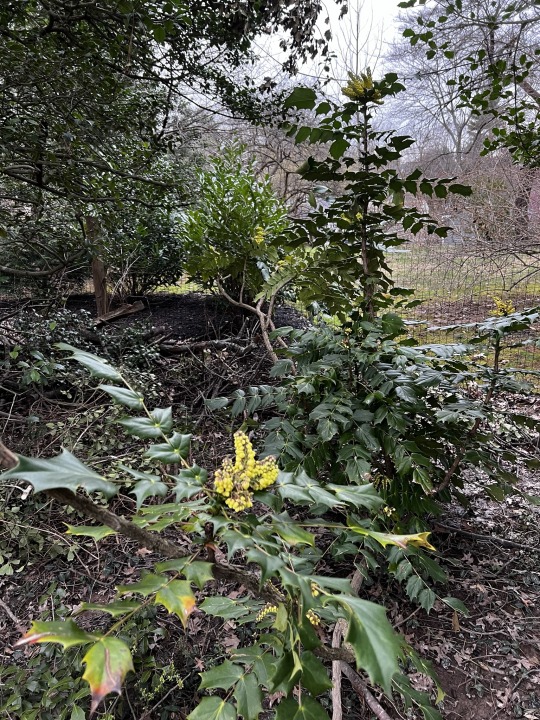
Mahonia Aquafolium, Oregon grape. If there is one plant in our garden that gets extra care, it is the Oregon Grape. It sits way in the back and, other than the trees, is one of the few plants in the garden I did not buy or plant. When we first moved in, it was in horrible shape and nearly dying. But each spring, I provided it a shovel full of compost and laid on extra mulch and it sprung back to life. As you can see from one of the photos, it is surrounded by tall mature hollies, so every spring I prune the Holly branches to give the Oregon Grape an open path to the sunlight.
The scientific name Mahonia comes from the name of a famous plant expert and the word Aquafolium means holly-like leaves, which obviously look like their namesake. The plant grows primarily in the Northwest United States and Southwest Canada and is rarely seen or grown in the East. This is the state plant of Oregon and was first noted by Lewis and Clark in their Journal when they made it to the far Northwest where they grow naturally.
When the plant is in full bloom in early spring, the flowers are just spectacular, hundreds of neatly arranged blooms turning from green to yellow like ripening fruit held on the stems with purple undersides called sepalum, from the Greek for covering. The effect is rather hallucinogenic.
When the flowers fade, they are replaced by grape like fruit, which the birds enjoy. Native Americans in the region would make elixirs out of the grapes to cure kidney, stomach and skin problems as well as other ailments.
You can still buy tinctures of Oregon Grape on line and in natural supplement stores, but there is no good scientific evidence to support medicinal use. It does contain the compound called berberine, which has been proven to have both anti-microbial and anti-inflammatory qualities. One of the main actions of berberine is to activate an enzyme inside cells called AMP-activated protein kinase (AMPK), according to some animal studies. AMPK is found in the cells throughout the human body and plays a role in regulating metabolism and energy levels. But none of that means the Oregon Grape tinctures work to do anything.
The plant is known to grow around poison oak out west and, in our garden, I always see poison ivy around it. Maybe that contributes to the folk wisdom associated with the plant. It is a living growing paradox. Its beautiful flowers entice the onlooker to approach but pointed needles of the leaves can puncture the skin. The surrounding poison ivy and oak lead to an awful itchy rash but the tincture made from the flowers and roots can treat and heal the skin rash.
As with other things it is known to do but really can’t, placing three branches of Oregon Grape on one’s threshold keeps enemies at bay.

0 notes
Text


Jonquils, daffodils, narcissus.
Daffodils are the common name for Narcissus. So what are Jonquils? They are a type of daffodil, though half the size of their brethren. So all Jonquils are daffodils and narcissus but the contrary is not true. They are different from the common daffodil in a number of ways, not just that they are much smaller and earlier to bloom, but structurally as well..
First, where the leaves of the common daffodil are strap like and thin, the leaves of Jonquils are tubular and rush-like, hence the name which means “rush” in Greek. The inside of the Jonquil leaves contain what is called a spongy pith. (How’s that for a new word? Not “pithy” but “pith.”) In botany, “pith” is the soft central cylynder of parenchymatous plant tissues. (The pulp of fruit are pith.)
Jonquils also tend to bloom clusters of several flowers as opposed to the one large bloom of most daffodils. Their greatest gift, however, is that they bloom right after the crocus in March while their bigger cousins put on a much bigger show in April.
The other interesting quality of Jonquils is that, unlike most daffodils, they have a scent. They contain what is called Narcissus Absolute, an oil used in many perfumes and medicinally to treat stress, insomnia, muscular spasms, aches and pains, tension, anxiety, and troubled minds. Chemically, the stuff is four parts benzoate: 24.4% benzo acetate, 21% benzyl alcohol, 2.18 % benzyl benzoate, and 0.18% benzyl cyanide. All of these are quite close to benzene, a known carcinogen.
There is an odd origin story about jonquils. Pluto, the god of the underworld, kidnapped Proserpina, who was out gathering lilies, and took her to his den to be his bride. In her terror, she dropped the flowers which turned into jonquils.
0 notes
Text
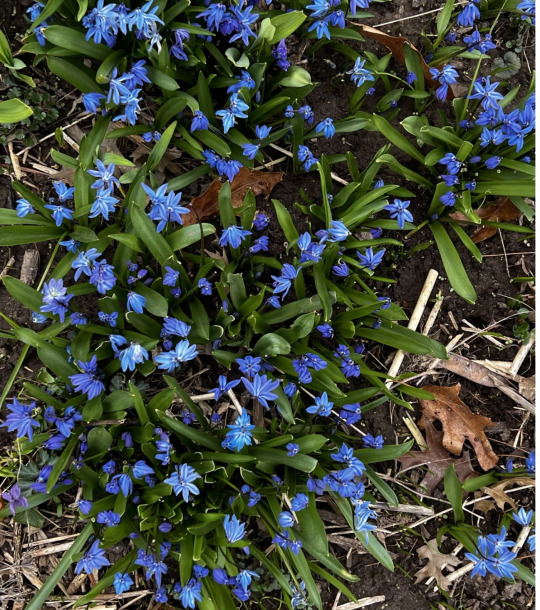
Scilla, Siberian squill.
Fist the snowdrops, then the crocus, then the Siberian squill. At least in our garden, these three are always the first to bloom starting in mid-February. It’s hard to pick a favorite of the three. For some reason, though, Siberian squill get the short end of the gardener’s stick.
Everyone loves the snowdrops as their numbers grow each year, and no one seems to mind that the snow crocus pop up everywhere year after year, not just in the garden but the lawn as well. But only the Siberian squill are called by that dreaded garden word “invasive.” In one garden guide, the author demanded in large letters “Do not plant these flowers,” advising the gardener to stamp on them so they would not rise again next spring. As Ezra might say “Stick it in your ear, garden guide.” I love these flowers. They are what is called Prussian Blue, the whole flower, pistils and stamens and all. They are in fact the bluest flowers to bloom all year.
Siberian squill are in the Scilla family, the same family as the Virginia Bluebells, much loved larger plants which bloom mid Spring. But these plants are barely 5 inches high with timy blooms.
Just about the whole plant is toxic. Most of the small early bulbs are eaten like candy by the squirrels, chipmunks, and mice. But the Scilla bulb contains the compound scilliroside, an ingredient in some rat poisons, so the rodents know to leave them alone. This gives the squill free rein to spread in the garden.
The plant’s family name derives from the mythological figure Scylla. She was the daughter of King Nesus of Megara, but betrayed him for the love of his rival King Minos. Minos rightfully was horrified by her act of patricide and rejected her love. In grief, she threw herself from the cliffs into the sea and was transformed into a sea monster shown below. The bitter Scylla spent her days destroying every ship attempting to cross the Strait of Messina.
If I am not wrong, I think Starbucks chose her for its logo.

In any event, the god Poseidon later managed to take her to what must have been a very large bed and, as a gift, transformed her into the beautiful cliffs off the coast of Sicily that bear her name.
Lastly, Asher may be interested to know, in hoodoo, practiced by slaves in the American south, placing squill in a container with one coin of each denomination draws in an abundance of fresh cash.
0 notes
Text

Aah the Snow Crocus bloomed today. They usually bloom around Valentine’s Day, hence they and not the rose are the love flower. After all, the first crocus were found on the field after Zeus and Hera made love one day.
Most people go for the hybrid crocus, which bloom later with much bigger and showier flowers. I prefer the Snow Crocus, untouched by the hybridizers, which multiply rapidly year after year.
Crocus are magical. They have the power of thermonasty meaning when the weather warms the petals grow more on the inside than the outside, allowing the flower to open.
Only the fall crocus have saffron. The spring variety are inedible and can be harmful if any parts are eaten. Another misconception is that crocus grow from corms not bulbs. Bulbs are modified leaves that store nutrients while corms store all the organs of the plant.
0 notes
Text
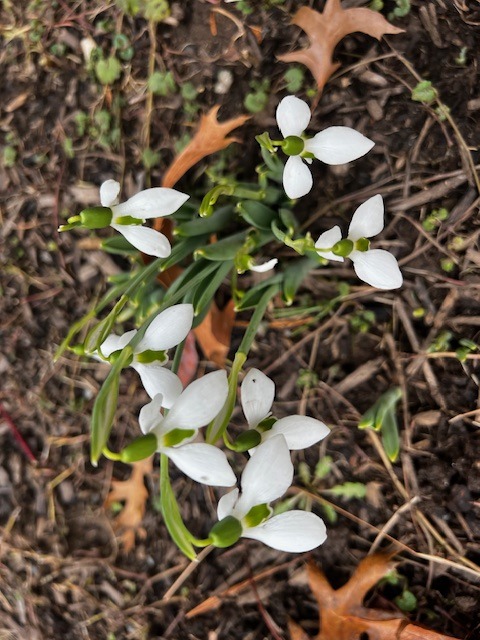
It's cold and windy, but mid January is when our Snowdrops always bloom. When God expelled Eve and her accuser, the hopeless Adam, from paradise, they left saddened and dejected and shivering in the cold. One kind Angel reached out her hand to catch the falling snowflakes. As they melted, she brought them to her face and breathed, transforming them into the perfect small flowers which she cast into a halo protecting the first humans. Her words: “Take these little flowers, take them as a sign of hope. A sign for your kind and for the earth outside.”
If only that were true.
0 notes
Text
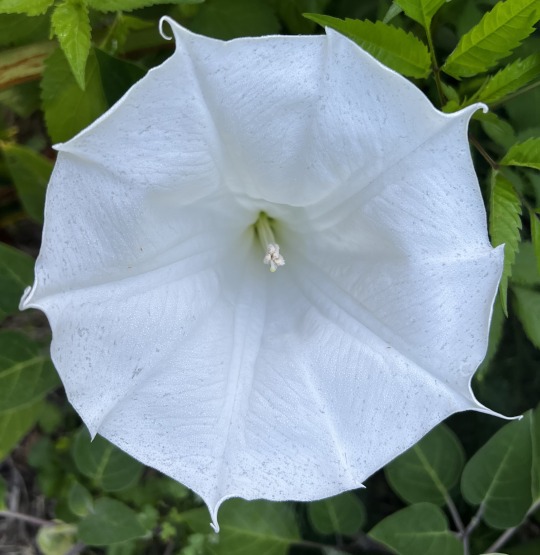

Datura, Jimson Weed, Devil’s Trumpets. Datura is a member of the Nightshade family, a group of a thousand or so plants that contain the alkaloid Solanaceae. The family includes tomatoes, potatoes, peppers, egg plants, all obviously edible and safe for humans.
But it also includes Datura, sometimes called the most dangerous plant in the world.
Devil’s Trumpets are not to be confused with Angel’s Trumpets, which Josh and Annie had growing at their previous house. Angel’s Trumpets, called Brugmansia, are not as toxic and point downward while Devil’s Trumpets look to the sky.
Virtually every part of the plant is dangerously toxic and hallucinogenic. Their effects on humans are summarized with this little ditty: “Blind as a bat, mad as a hatter, red as a beet, dry as a bone.”
The flowers are quite stunning. Like other Nightshade plants, they bloom at night, hence the name. In the morning they are the brightest white, nearly 5inches across. What I like are the little curly cues at the end of each petal section.
For centuries, Datura has been used as an effective poison. At the end of Nathaniel Hawthorne’s “The Scarlet Letter,” the Reverend Dimmesdale who had gotten Hester Prynne pregnant in an adulterous affair, poisons himself out of guilt with Datura, which Hawthorne calls “apple Peru.”
Despite its toxicity, Datura was the drug of choice for the Navaho and the Aztecs when they needed to commune with the spirit world. The most common method of using the plant is to smoke its leave but some have chosen to bathe in water containing a whole plant, one of the strangest ways to get high.

Above you can see Georgia O’Keefe’s painting: “Jimson Weed, White Flower No. 1.” It sold at Sotheby’s in 2014 for $44.4 million, the highest price ever for a work by a woman artist.
0 notes
Text
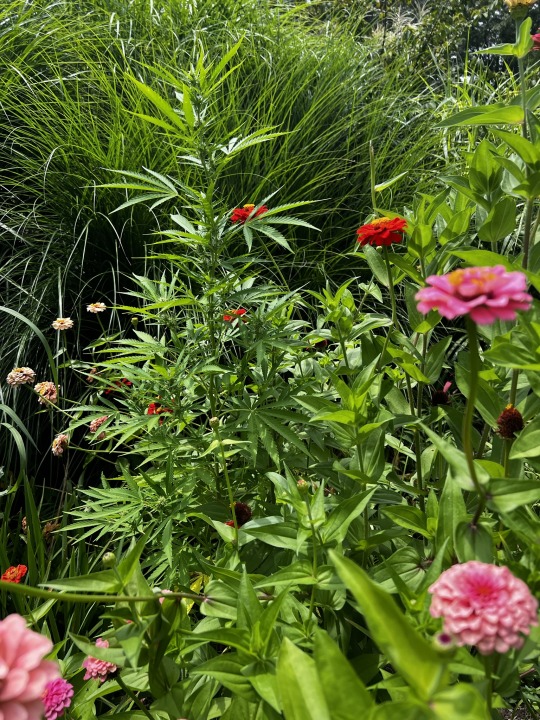
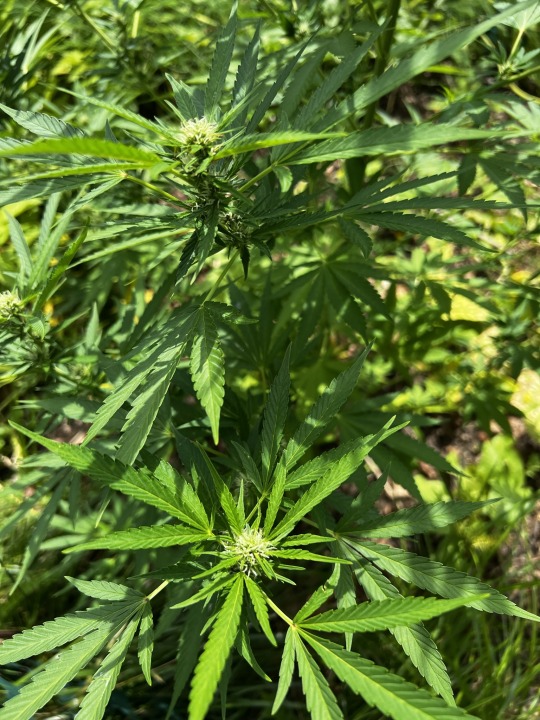
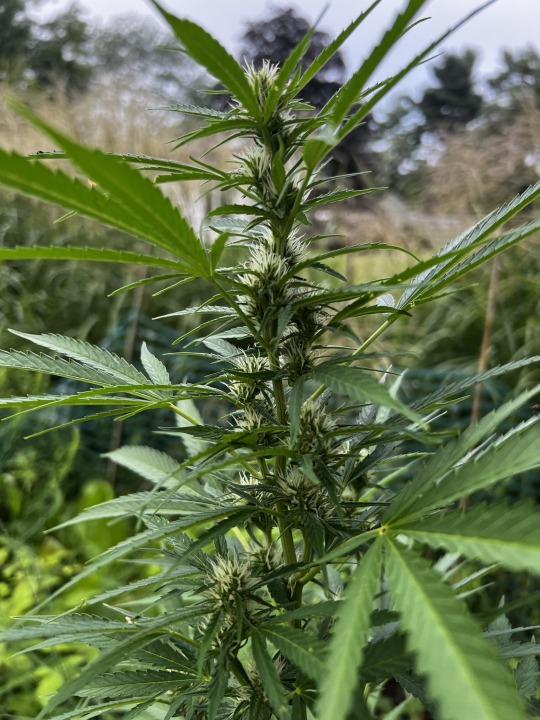
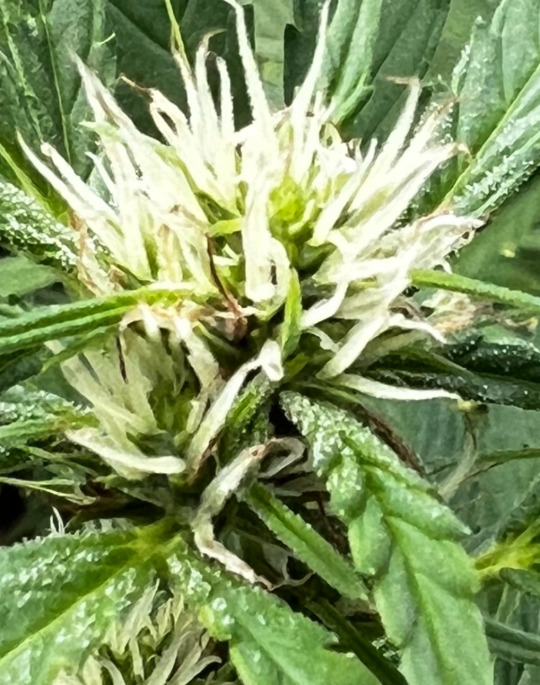
Cannabis, Marijuana. This year’s crop is just beautiful and already six feet tall. It is the same strain as last year’s: Acapulco Gold.
You might recall the etymology of the various names for the plant in last year’s post. “Cannabis” comes from the Scythians word “kanab” which the Greeks made into κάνναβις or kánnabis, their word for “hemp.” “Marijuana” has its origins in a Central African word “mariamba,” used by American slaves in the 1700s, which became the Spanish word “marihuana,” again meaning “hemp.” “Pot” comes from the Spanish phrase “potacion de guaya,” which is a wine or brandy used to soak Cannabis buds during the 1930s. And “grass” comes from the thousand-year- old Hindu text Atharvaveda, in which the plant is deified as “Sacred Grass.”
The anatomy of the plant is quite amazing and remarkably engineered. The entire flower structure is called the “cola.” If you look at the close up, you can see small pear-shaped leaves within the structure. These are called “brachts,” designed to protect the precious flowers or buds. The white threads in the flowers are the pistils and would catch the pollen from a male plant if the gardener foolishly allowed males to mix with the girls and produce seeds. The pistils should turn to a goldish brown when the season ends and the plant is ready for harvesting. The white dots are the trichomes, small hairs from the epidermis of the plant. These are heavy in THC content and keep the deer and other wildlife from attacking the plant and being too wonked out to find their way home. The flowers continue to multiply up and down the plants at the bases of the gorgeous fan leaves.
Last year and this, I grew Acapulco Gold because it was a favorite in my college dorm. It is what in tomato plants would be called an heirloom plant. It was an original strain of cannabis and is eschewed by today’s growers because the plants prefer the outside air and do not do well indoors. The stems are strong, as evidenced by the fact we have had some ferocious storms this summer and nary a leaf has been shed.
Acapulco Gold was traditionally cultivated in the Guerrero Mountains outside the city. In the seventies, no less an authority than the Oxford English Dictionary called it "a special grade of cannabis . . . with a color of brownish gold, or a mixture of gold and green.” It has also been called "connoisseur pot," Another report from the time highlighted its "exquisite taste."
It was the favorite strain of such luminaries as Jack Nicholson, Mick Jagger and rock photographer Paul Ferrara. Reportedly, NFL Commissioner Pete Rozelle tried it to understand if marijuana would cause problems for his players. And it was in the joint my father famously brought back for his kids when he and my mother vacationed in Acapulco.
Acapulco Gold is still an icon of the counter-culture, still being written about 60 years on. It appeared prominently in literature and film of that golden era. The 1972 novel Acapulco Gold by Edwin Corey, set in an impossible to imagine future world where marijuana would be legal, described the competition among advertising agencies to market it. Norman Spinrad’s novel Bug Jack Barron similarly described a futuristic world where the leading brand Acapulco Gold was promoted in a commercial like this:
"In the high country of Mexico evolved a savoury strain of marijuana which came to be known as Acapulco Gold in the days of the contraband trade. Prized for its superior flavor and properties, Acapulco Gold was available only to the favored few due to its rarity and the difficulties involved in importation."
In Cheech and Chong’s classic film, Up in Smoke, Cheech says "You know like I smoke that Acapulco Gold, man," and in the duo’s debut album, he sings, "No stems no seeds that you don't need, Acapulco Gold is some badass weed."
In their debut album, the New Riders of the Purple Sage, with Jerry Garcia on the pedal steel, included a song titled “Henry.” They sang:
Every year along about this time it all goes dry
There's nothing round for love or money
That'll get you high
Henry got pissed off and said he'd run to Mexico
To see if he could come back holdin'
Twenty keys of Acapulco Gold
Now the road to Acapulco is very hard indeed
And it isn't any better if you haven't any weed.
0 notes
Photo


Hordeum vulgare, Barley. Here’s a strange one. Growing in the patio garden are four stalks of barley. I had to use my plant finder app to figure out what this beautiful flowering grass was. I can’t imagine where the nearest barley field is that would allow a bird or the wind to spread its seed to our modest home.
The flower really is striking, particularly when it catches the rays of the early morning sun like in the bottom photo. A sparsely leafed stalk rises first, then the flowers appear with each kernel sending high in the air a thin wiry strand to wave in the wind with its companions. I might grow some every year.
Barley was one of the first crops domesticated by humans about 10,000 years ago when farming first began. The name comes from the Scottish “bere” which dates from the Latin for “grain.” The word itself is the source for the word “barn” which meant barley shed.
Barley was the grain of the common folk who used it make not just bread but beer, a word that comes from the German word for “barley.” You can discern its commoner roots from the numerous references to barley in the Bible such as this verse from Kings:
“A man came from Baal Shalishah, bringing the man of God twenty loaves of barley bread baked from the first ripe grain, along with some heads of new grain. “Give it to the people to eat,” Elisha said. “How can I set this before a hundred men?” his servant asked. But Elisha answered, “Give it to the people to eat. For this is what the LORD says: ‘They will eat and have some left over.’ ”
Barley was so essential to ancient daily life that it was used to measure size and weight. A “barleycorn” or one grain of barley was equal to 1/3 of an inch; 36 barleycorns made a foot. And a carat, used to measure the weight of stones and gems, was the equivalent of three barleycorns.
The old Scottish song, adapted by Steve Winwood, personifies the growing and harvesting of Barley. I played the song repeatedly my freshman year of college.
https://www.google.com/search?q=john+barleycornmust+die&client=safari&rls=en&ei=IkOPZO_aCYme5NoPtZK4wA4&ved=0ahUKEwjv8_-QsM3_AhUJD1kFHTUJDugQ4dUDCBA&uact=5&oq=john+barleycornmust+die&gs_lcp=Cgxnd3Mtd2l6LXNlcnAQAzIKCC4QDRDUAhCABDIHCAAQDRCABDIHCAAQDRCABDIHCAAQDRCABDIHCAAQDRCABDIKCC4QDRDUAhCABDIHCAAQDRCABDIHCC4QDRCABDIHCAAQDRCABDIHCAAQDRCABDIYCC4QDRDUAhCABBCXBRDcBBDeBBDgBBgBOgoIABBHENYEELADOhYILhANEIAEELEDEIMBELEDEIMBENQCOhAILhANEIMBENQCELEDEIAEOg0ILhANEIAEEMcBEK8BSgQIQRgASgUIQBIBMVDUBFjZEGDAFWgBcAB4AIABaYgB_QWSAQM4LjGYAQCgAQHAAQHIAQjaAQYIARABGBQ&sclient=gws-wiz-serp#fpstate=ive&vld=cid:2e2b79a2,vid:t8878chOvfI
Here are the lyrics to the old folksong:
There were three men come from the West
Their fortunes for to try,
And these three made a solemn vow:
"John Barleycorn must die."
They plowed, they sowed, they harrowed him in,
Threw clods upon his head,
'Til these three men were satisfied
John Barleycorn was dead.
They let him lie for a very long time,
'Til the rains from heaven did fall,
When little Sir John raised up his head
And so amazed them all.
They let him stand 'til Mid-Summer's Day
When he looked both pale and wan;
Then little Sir John grew a long, long beard
And so became a man.
They hired men with their scythes so sharp
To cut him off at the knee;
They rolled him and tied him around the waist,
And served him barbarously.
They hired men with their sharp pitchforks
To pierce him to the heart,
But the loader did serve him worse than that,
For he bound him to the cart.
They wheeled him 'round and around the field
'Til they came unto a barn,
And there they took a solemn oath
On poor John Barleycorn.
They hired men with their crab-tree sticks
To split him skin from bone,
But the miller did serve him worse than that,
For he ground him between two stones.
There's little Sir John in the nut-brown bowl,
And there's brandy in the glass,
And little Sir John in the nut-brown bowl
Proved the strongest man at last.
The huntsman cannot hunt the fox
Nor loudly blow his horn
And the tinker cannot mend his pots
Without John Barleycorn.
0 notes
Text

Scabiosa, Pincushion flower. The scientific name comes from the Latin “scabiosus” meaning mangy, rough or itchy. The strange thing is the name refers not to the flower or even the plant but the symptoms one feels when afflicted with a skin condition called “scabies” that the plant has been used to treat. This skin irritation is caused by a microscopic mite called Sarcoptes scabiei, pictured below, which makes its home in the upper layer of human skin where it lives and lays its eggs. (A mite by the way is not an insect but an arachnid like a spider.) The unfortunate victim of this mite suffers from intense itching and a pimple-like skin rash.
The Pincushion flower has been a folk medicine remedy to treat this skin condition for more than 2000 years, but even the cure is rather odd, at least the current recipe. You take the leaves of the plant and soak them in water and then throw in a mix of fennel and marshmallows. Yes, marshmallows. Bring the concoction to a boil and pour it into a bath. Sit and soak until presumably the mites and their eggs die. You then emerge hopefully free of the itch but smelling of sticky marshmallow and fennel, a scent I would think is not very pleasant.
The leaves of the plant are rather hairy and partly divided into lobes, though a few of the leaves are smooth. The outer buds slowly open and you can see they are composed of tiny yellowish green individual florets. Then these buds open and the flowers emerge, giving the impression of a single bloom. This ruby red variety is quite striking. If you pull apart the petals, you can see each of the individual florets have their own dark stamens. The blooms last from mid spring through summer.
All in all, a nice addition to the garden. If only, they would change the scientific name.
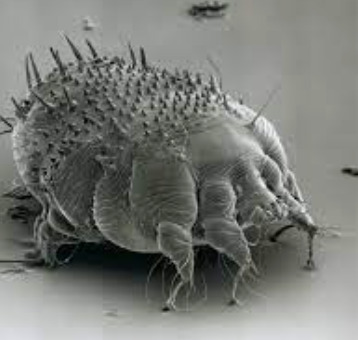
1 note
·
View note
Photo
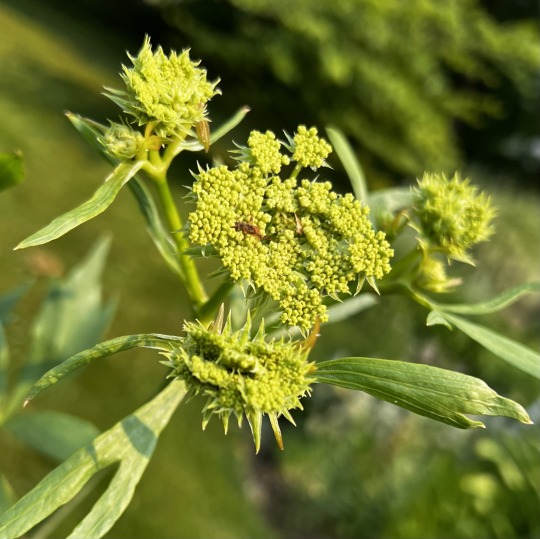

Lecisticum Officinale, Lovage, Mountain celery, Smellage, Maggi plant, Bald money. Lovage used to be grown in every herb garden and, with its celery-like flavor, was a staple in every kitchen. It is native to Asia and Europe and was brought to North America by the early colonists.
The scientific name is a variation of Liguria, an Italian city where it was grown extensively. The name “Lovage” means “love ache,” ache being the medieval name for parsley. As you might have guessed, the “love” in “lovage” stems from its wide use as an aphrodisiac and love potion. When couples married, brides placed lovage in their hair or attached the leaves to their dresses during the ceremony presumably to get the couple’s juices flowing. Then they buried lovage with three threads--red green and white—along the foundation wall of their new home to ensure permanent love and good fortune.
That last common name, Bald money, is a reference to the god Balder, called the Norse Apollo, impervious to harm except for a single weakness. But it wasn’t his heel, like it was for Apollo, it was mistletoe, which is rather odd given the loving reputation of lovage and for what we now associate mistletoe.
While not that attractive, the plant is quite a specimen. After dying down to the ground in winter, it grows up to six feet tall by mid spring. The leaves are large and oddly shaped, almost forked. The flowers are a collection of yellowish green buttons, again nothing to write home about. At the end of the season, the hollow stems are traditionally broken up and made into a tasty straw for the perfect Bloody Mary. (I will let you how that goes in October.)
The root for such a vigorous grower is quite deep and has been used for medicinal purposes, mostly to treat urinary infections and fluid retention. Benedictine Monks, who treasure peace and silence, famously made lovage tea to control flatulence.
And to complete their usefulness in the garden, the flowers attract tiny parasitic wasps which like to feast on mosquitos and tent caterpillars.
0 notes